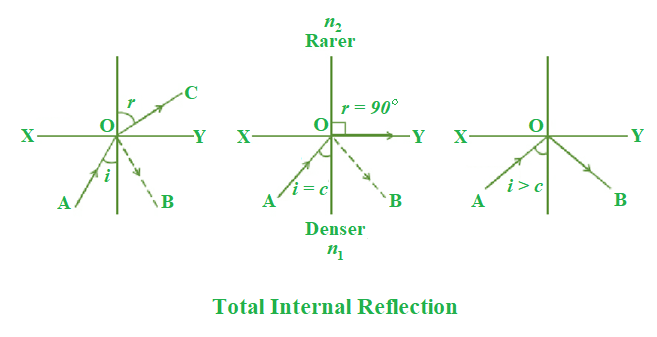全内反射
您可能已经看到钻石闪闪发光。你知道钻石为什么那么耀眼吗?或者,想象一下你在玻璃下面放一分钱,然后装满水。硬币从侧面看是看不到的,但从上面看是看得见的。是什么导致这种情况发生?内部自省是其中的关键。让我们仔细看看完整的内部反射。
全内反射
让我们做一个简短的任务,以更好地掌握全面内部反思的概念。拿一枚硬币和一个玻璃杯,把它们放在一起。将一分钱放在玻璃杯底部,然后装满水。硬币怎么了?我们可以从玻璃的顶部看到硬币,但当我们从侧面看时却看不到。我们看不到硬币,因为它对我们来说是不可见的。是什么导致了这种情况发生?
这是因为当玻璃杯中有水时,硬币发出的光会以一定的角度穿过玻璃杯到达我们的视线。此外,当向玻璃中添加水时,来自线圈的光以高于临界角的角度照射到玻璃内部。里面的玻璃反射 100% 的光。内部反射就是这样。
The full reflection of a light ray at the boundary of two media when the beam is in the medium with a higher refractive index is known as total internal reflection.
当光束从光密度较高的材料射向光密度较低的介质时,就会发生这种现象。发生全内反射有两种情况:
- 当光线从密度较大的介质接近密度较小的介质时。
- 如果入射角大于临界角。
全内反射示意图
考虑下面的情况。一束光从水介质传播到空气中。光线将在两种介质相遇的点发生折射。折射光束在从具有较高折射率的介质传递到具有较低折射率的介质时偏离法线弯曲。
- 入射光束以一定的入射角在水面上传播的方式发生折射。
- 临界角是发生某事的入射角。这里的折射角是 90°。
- 当入射角大于临界角时,入射光线被反射回介质。这个事件被称为全内反射。

通过以上观察,我们可以得出两个公式:
- 全内反射
n1 ⁄ n2 = sin r ⁄ sin i
where,
- i is the angle of incidence,
- r is the angle of refraction,
- n1 is the denser medium, &
- n2 is the rarer medium.
- 临界角
θc = sin−1(n2 ⁄ n1)
where, θc is the critical angle.
全内反射示例
- 光纤
因为入射光束产生的角度高于临界角,所以当它撞击包层时会发生全内反射。光纤已经彻底改变了信号在城市、国家和大陆之间的传输速度,使电信成为最快的信息传输形式之一。内窥镜检查也使用光纤。
- 海市蜃楼
这是一种视觉错觉,导致水层出现在沙漠或道路上的短距离内。由于大气折射而发生的全内反射就是海市蜃楼的一个例子。
- 钻石
当光线穿透钻石时,它们会完全内化并反射到钻石的所有刻面。从钻石射向空气的光束的关键角度仅为 24°。结果,大多数入射光子经历了完全的内部反射。
此外,钻石通常以这样的方式切割,当光束穿透它们时,它会在多个面上受到全内反射。当任何面的入射角小于 24° 时,光线就会透过,使钻石看起来很明亮。光纤也采用全内反射。视频和音频信号使用光纤远距离发送。
示例问题
问题1:折射率为n 1 = 1.33 的玻璃由一根光纤构成,周围是另一块折射率为n 2的玻璃。确定包层的折射率 n 2 ,使两个包层之间的临界角为 30 ° 。
回答:
Given:
Critical angle, θ = 50°
Refractive index, n1 = 1.33
Critical Angle
θc = sin−1(n2 ⁄ n1)
n2 = n1 sinθc
= 1.33 × sin 30°
= 0.665
Hence, the refractive index of the second glass is 0.665.
问题2:确定临界角为45°的介质的折射率。
回答:
Critical angle, θc = 45°
Refractive index of the medium, μ = 1 ⁄ sin θc
μ = 1 ⁄ sin 45°
= 1.414
Hence, the refractive index of a medium is 1.414.
问题 3:假设一束光从折射率为 1.33 的介质传播到折射率为 1.50 的介质。如果入射光线与法线成 50°角,临界角是多少?
回答:
Light is said to go from one medium to another in response to this query. We’re provided with the refraction indices for both media, as well as the incidence angle relative to the normal, and we’re asked to calculate the critical angle. It’s crucial to keep in mind that as the light goes from one medium to another, the speed at which it travels changes.
The index of refraction of a medium is determined by how fast light travels in that medium compared to how fast light travels in a vacuum. Light bends more strongly towards the normal in denser media, whereas it bends farther away from the normal in a less dense medium. The light must move from a medium with a higher density to a medium with a lower density in order to reach a critical angle. To put it another way, light must move from a medium with a higher refraction index to one with a lower refraction index.
As a result, if a ray of light is moving from a medium with a low index of refraction to a media with a greater index of refraction, there will be no critical angle. This is exactly what is going on in the question stem. As a result, there can’t be a critical angle.
问题 4:当光在两种液体中的波长 x 和 y 分别为 250 nm 和 500 nm 时,x 相对于 y 的临界角是多少?
回答:
Given:
Wavelengths, λx = 250 nm and λy = 500 nm
θc = sin−1(ny ⁄ nx) = sin−1(λx ⁄ λy)
θc = sin−1(250 nm ⁄ 500 nm)
= 30°
Hence, the critical angle of x relative to y is 30°.
问题 5:为什么完全内反射的图像看起来比镜子或透镜产生的图像更亮?
回答:
Total internal reflection produces brighter pictures than mirrors or lenses because 100% of incident light is reflected back into the same medium without loss of intensity, whereas reflection from mirrors and lenses always results in some loss of intensity.